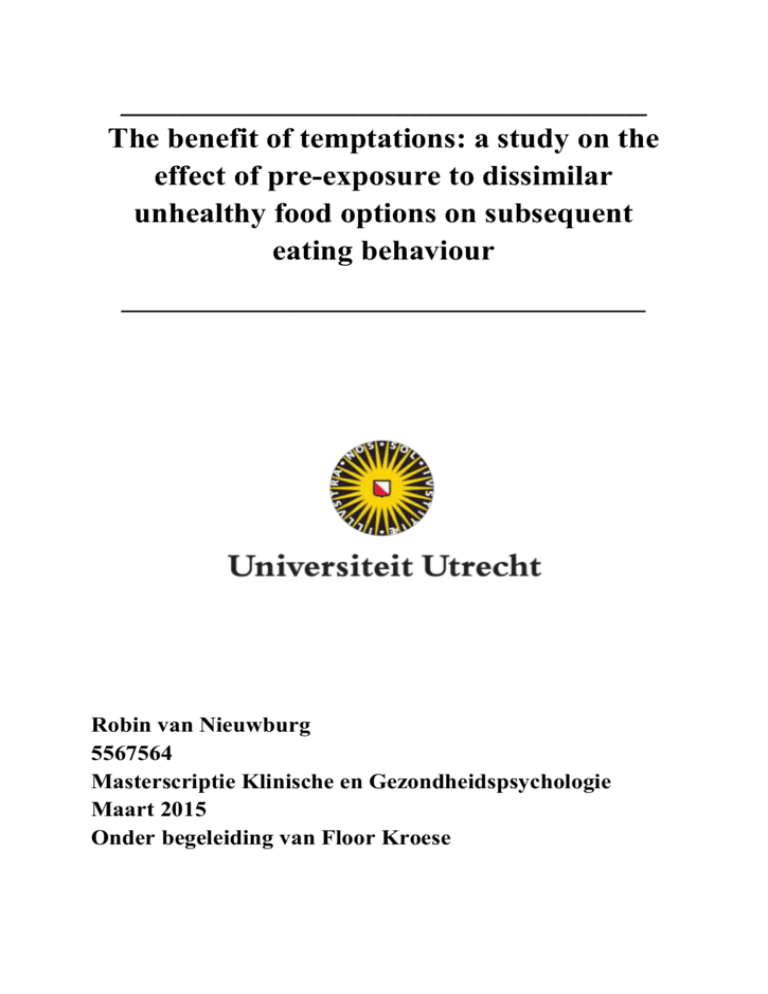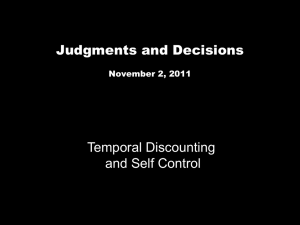Robin van Nieuwburg 5567564 Masterscriptie Klinische en
advertisement

__________________________________ The benefit of temptations: a study on the effect of pre-exposure to dissimilar unhealthy food options on subsequent eating behaviour _____________________________________ Robin van Nieuwburg 5567564 Masterscriptie Klinische en Gezondheidspsychologie Maart 2015 Onder begeleiding van Floor Kroese Abstract Background. Prior research has shown that temptations can have a favourable effect on selfregulation, under the right circumstances. Objective. Potential beneficial effects of preexposure to temptation on subsequent consumption of unhealthy food were examined, focusing on the effect of dissimilar food options in an actionable temptation phase followed by the consumption phase. Method. Data was collected from 109 females, using a 2 (preexposure: temptation vs. controls) x 2 (consumption: chocolate vs. chips) between-subjects design. Pre-exposure situation and consumption situation were the independent variables and the amount consumed was the dependent variable. The existence and importance of a dieting goal, self-regulatory success and BMI scores were established. Results. No main effect for pre-exposure situation was found, but consumption situation did yield a main effect meaning that participants ate significantly more in the chocolate consumption condition. The interaction effect was not significant. However, a trend was found for temptation within the chocolate consumption group. Conclusion. The result of this study suggests that there is ground for a food-specific suppression of the eating goal, but not for an overarching dieting goal. These assumptions are based on a trend seen in the data, but findings did not reach significance. 1 A chocolate cake in the shop window, a bag of chips on the table at your friend’s house or a hamburger peeking at you from the grill in a restaurant. We are all exposed to unhealthy food temptations on a daily basis. In general, most people want to stay healthy and not get fat as a result of overeating. This is where the conflict hits in; should you put your health on the line for a short-term positive outcome, i.e. consume the unhealthy snack, or resist the temptation to pursue your long-term dieting goal? In contrast to what most people would expect, there has been research showing that exposure to unhealthy food, for example a chocolate chip cookie, can have a favourable effect: it makes people with a dieting goal consume less than people who have not been exposed to an actual temptation (e.g. Geyskens, Dewitte, Pandelaere & Warlop, 2008). In the current study, we aim to further scrutinize the potential beneficial effects of pre-exposure to temptation on subsequent consumption of unhealthy food. The struggle between people’s desire to eat and their willpower to keep to their longterm health goal causes a self-control conflict (Geyskens et al., 2008; Hoch & Loewenstein, 1991). The short-term benefit of consuming a snack threatens their long-term interest of dieting. The most logic and therefore most explored idea is that exposure to a food temptation stimulates consumption, because the temptation serves as a reminder to eat (Wansink, 2004). Ironically, this seems to be particularly true for people who try to restrict their food intake, also known as ‘restrained eaters’. Fedoroff, Polivy and Herman (1997) showed in their research that restrained eaters, after being exposed to the smell of pizza, had a significant greater food intake in comparison to the unrestrained eaters. According to Lwin and colleagues (2014), restrained eaters are distinguished from unrestrained eaters because of their major worries about food consumption. They are constantly trying to resist internal urges to eat and most of them designed their own set of restrictions when it comes to caloric intake (Lwin et al., 2014). Thus, people who worry about their weight but tend to be unsuccessful dieters seem to forget their long-term goal when they are tempted and solve the self-control conflict by indulging. With indulgence as the first solution to this conflict, control is the second. Exposure to a temptation can lead to the activation of the appropriate control mechanisms to protect people’s long-term goals. According to the Counteractive Control Theory, activated selfcontrol can defeat the threat of not keeping to the long-term goal (Fishbach & Trope, 2005). Self-control can counteract the influence of short-term allurements to protect the long-term goal by engaging in a set of motivational, cognitive and emotional processes (Trope & Fishbach, 2000). These processes are from now on referred to as self-control strategies. 2 People can adopt conscious self-control strategies first by aiming to change the choice alternatives and their subjective evaluations, for example by implementing a punishment or reward for the choice-related behaviour. For consuming an unhealthy snack people can set a monetary penalty; they have to put a euro in a jar. Second, self-control strategies can be used to change the psychological meaning of these situations. People may use a set of strategies to reinforce the value of their long-term goal, for example by attaching the outcome of this goal to their self-standards. They do this by focusing on why it is so important to maintain or lose weight, for example because of a potential diabetes threat or in order to not get bullied (Fishbach & Trope, 2005). Self-control strategies can also work on an unconscious level. People with a dieting goal show a faster pushing response to temptation stimuli because an implicit choice of action is elicited by the activation of their long-term interest. The stronger the temptation, the stronger the avoidance response (Fishbach & Shah, 2006). Fishbach and colleagues (2003) found that people in the food prime condition, where they sat in a room with fattening foods all around them, recognized the word diet as fast as people who were in the diet prime condition during the lexical decision task. People in the diet prime condition sat in a room with dieting magazines and books spread out over the room. The overarching dieting goal seemed to be activated, even in participants in the food prime condition, who had been tempted with unhealthy food. The behavioural strategy used by participants in the food prime condition was then avoiding the fattening food and choosing healthier food options in the end of the research. This strategy was not as much used by participants in the diet and neutral prime conditions. Thus, after activation of the dieting goal, temptations seem to generate selfcontrol strategies in order to eliminate the tempting stimulus (Fishbach et al., 2003). In sum, unhealthy food options can be seen as ‘alarm bells’ which first activate the high-priority goal of dieting, and second, activate behavioural self-control strategies. The Counteractive Control Theory clarifies why certain people can deal with temptations in an effective way. 3 Figure 1. “The influence of short-term outcomes on choice and action” (Fishbach & Trope, 2005). Supporting the Counteractive Control Theory, Fishbach, Friedman and Kruglanski (2003) found that food temptations activate the overriding dieting goal on an automatic, unconscious level. This link between temptations and goals is moderated by two factors. First, by the level of importance of this goal. Counteractive control processes are only activated when people attach high value to the goal outcomes. Only then, self-control strategies are set in motion (Trope & Fishbach, 2000). The second moderator of the link between temptations and goals is self-regulatory success. Papies, Stroebe and Aarts (2008) emphasize their finding that the overarching dieting goal is only activated, and self-regulation is only then facilitated in successful restrained eaters. In unsuccessful restrained eaters, the temptation inhibits the dieting goal, leading to more consumption (Papies et al., 2008). It appears that only people with a dieting goal being successful in self-control consumed less after being exposed to an unhealthy temptation. People low on self-control did not show this result (Haynes, Kemps, Moffitt & Mohr, 2014). Successful self-regulators show to be even more predisposed to keep to their goal and avoid temptation when the perceived temptation comes off as particularly strong. Unsuccessful self-regulators fail to do so in most cases (Fishbach & Trope, 2005; Fishbach & Shah, 2006). In conclusion, the two important factors contributing to the activation of the dieting goal following exposure to unhealthy food cues are goal importance and successful self-regulation. It is important to note that people only activate consumption preventing self-control strategies when a self-control conflict is elicited (Do Vale, Pieters & Zeelenberg, 2008). Selfcontrol strategies need to be triggered to a certain critical level beyond which these strategies are exceeded. In line with this argument, Geyskens and colleagues (2008) showed that temptation actionability during pre-exposure plays a pivotal role. Only when the prior food temptation is actionable, i.e. there is an opportunity to actually eat the tempting food like real 4 M&M’s, the eating goal is suppressed in the subsequent eating opportunity. This means that self-control is enhanced by being exposed to actionable food temptations prior to a subsequent consumption situation. In case the food temptation during pre-exposure is nonactionable, i.e. pictures of M&M’s, the eating goal is not suppressed in the subsequent eating opportunity (Geyskens et al, 2008). The importance of self-control being triggered to a certain level potentially explains why nonactionable food temptations do not elicit these strategies because only a picture of tempting food does not form a threat to an overarching dieting goal. Actionable food temptations do pose a threat, which exceeds the critical level. In that case, self-control strategies are triggered and they inhibit the urge to eat the unhealthy food in a subsequent eating situation (Geyskens et al., 2008). In sum, prior research has shown that temptations can have a favourable effect on selfregulation, under the right circumstances. Goal importance, successful self-regulation and temptation strength are all of great importance in this process. Although theoretically it seems to be assumed that a general dieting goal is activated upon temptation exposure, it is as of yet unclear if this is really the case. In prior research, the food in the temptation phase has always been similar to the food in the consumption phase. Geyskens and colleagues (2008) demonstrated that participants exposed to a bowl filled with chocolate showed lower food consumption of M&M’s in the consumption phase than the controls who had not been exposed to the actionable food temptation of chocolate, and the participants exposed to nonactionable cues of chocolate. Less is known about the effect of less similar food options between both phases, for example chocolates in the temptation phase followed by chips in the consumption phase. In case self-control strategies are also activated in order to pursue the dieting goal when exposed to divergent food options in the temptation and consumption phase, this would point to the possibility of a general suppression of the eating goal and general activation of the overarching dieting goal (Geyskens et al., 2008). If this is not the case, it would be possible that people only learn how to deal with a specific temptation. Getting more understanding about the effect of temptations on self-control is not only of great theoretical relevance, but also of practical relevance. Realistically, people are exposed to a variety of unhealthy food temptations in the society we live in nowadays, not just to one specific food temptation. The only studies that did look at dissimilar foods used a nonactionable temptation situation, that did not yield counteractive control effects, but the opposite: people consumed more after exposure to temptation. Lambert, Neal, Noyes, Parker and Worrel (1991) stated that sight and taste cues of M&M’s induces craving and desire of the cued food, in this case 5 chocolate. Federoff, Polivy and Herman (2003) likewise reported that restrained eaters, after being exposed to the smell and thought of cookies and pizza, had more desire to eat this food compared to the controls. They only consumed more during the consumption phase when the non-actionable temptation (pizza) was highly similar to the food presented (pizza-related food), not when the food presented was from another kind of unhealthy food (cookies) (Federoff et al., 2003). Thus, we have learned from previous research that for nonactionable temptations, the cued food option is required to be similar to the food option in the consumption situation. The desire for the cued food leads to more consumption of only the cued food (Federoff et al., 2003). However, the current study focuses on the effect of dissimilar food options in an actionable temptation phase followed by the consumption phase. Participants will first be exposed to chocolate or not, and then consume chocolate or chips in the second part of the study. According to the Counteractive Control theory and previous research, the dieting goal is activated when exposed to actionable temptations, suggesting a generalized effect. Expected is that people who are exposed to chocolate activate the high-priority dieting goal, leading to less consumption than people in the control condition, who are not exposed to a temptation. People who are tempted with chocolate are expected to consume less chocolaterelated foods as well as, for example, unhealthy savory food like chips. This would point to the possibility of a general suppression of the eating goal and general activation of the overarching dieting goal (Geyskens et al., 2008). In this research, we focus on young women with a healthy weight who attach high value to maintaining this healthy weight, and therefore have a dieting goal. As an indicator of successful self-regulation we establish Body Mass Index scores to select women with a normal BMI. Papies and colleagues (2008) and Nguyen and Polivy (2014) both found that the lower the BMI score, the higher the self-regulatory success. Thus, women with a normal BMI are considered to be successful self-regulators. Young women are chosen as participants because most of them seem to be concerned with losing weight and staying skinny, while they are not overweight (Wardle, Haase & Steptoe, 2006). 6 Method Participants Hundred-and-thirty females participated in the current study in exchange for four euros or half a credit that they can add up to their total research credit score bachelor students need to receive their diploma. Participants not having a normal Body Mass Index according to the World Health Organisation (2014), lower than 18,5 and higher than 24,99, were excluded from the research data. Seven participants were excluded due to being underweight, against eight participants who were categorised as being overweight (total of N = 15), along with participants disliking the consumption product, M&M’s or chips (N = 2), and participants who did not consider the consumption product to be unhealthy (N = 2). The last two criteria are important because food only poses a temptation when it is considered to be both tasty and unhealthy (i.e., involving a conflict). Two participants were excluded due to missing values. The remaining hundred-and-nine female participants had a mean age of 20.8 years old (SD = 2.5) and a mean BMI of 21.6 (SD = 1.5). Design and Procedure The study consisted of a 2 (pre-exposure: temptation vs. controls) x 2 (consumption: chocolate vs. chips) between-subjects design. Participants were all female and randomly divided over the separate groups. During the pre-exposure phase, half of the participants were exposed to a chocolate temptation and the other half was part of the controls who were not exposed to a temptation. The consumption phase contained chocolate for one half and chips for the other half of the participants. After entering the laboratory and signing the information letter, the pre-exposure phase started during which participants were either or not exposed to a temptation and had to fill out the matching questionnaire. After that, the consumption phase started, where participants were asked to do a flavour test, either about chocolate or chips. The amount consumed during this phase is the dependent variable in the analysis. Following these two phases, participants filled out questionnaires about the existence and importance of a dieting goal and self-regulatory success. Finally, they were asked to write down their weight and height to establish BMI scores. After the research was done, participants received four euros or half a credit. During the debriefing, they were asked what they thought the purpose was of this research, to make sure participants were not aware of the hypothesis. Some participants designated temptation and self-control as the subject of the research. However, 7 none of the participants were able to guess the exact hypothesis. After that, they were informed what the research was about by the debriefing. Materials Pre-Exposure Phase. During the pre-exposure phase, participants in the temptation condition were asked to do a task where they had to answer questions about Quality Street chocolates. The chocolates were placed on the table so that the participants were exposed to an actionable chocolate temptation. However, a note said they were not allowed to eat the chocolates because they were needed for the research. The Quality Street chocolates were wrapped in eight different colours. The participants were asked what flavour belonged to what colour wrapper. For example, a green wrapper could mean a mint flavoured chocolate. Participants in the control condition were not exposed to the Quality Street chocolates, but had to answer questions about certain concepts, like snow, and their matching colour (Geyskens et al., 2008). Consumption Phase. During the consumption phase, participants were asked to do a flavour test. Participants in the chocolate condition were presented two bowls, each filled with a different kind of M&M’s. The first bowl contained crispy M&M’s, the second bowl contained regular M&M’s. Participants in the chips condition were presented with two bowls, each filled with a different kind of chips. The first bowl contained pepper flavoured chips, the second bowl contained regular chips. All participants had to fill out a questionnaire including a number of questions about the appearance and flavour of the two kinds of this type of product, how often they eat the product etc. They were told that they were allowed to eat as much as preferred, because the bowl would get refilled for the next participant. After a participant left the laboratory, the bowls were weighed to determine the amount of M&M’s or chips, depending on the condition, that was eaten. The difference between post and pre weight (in grams) was the dependent variable. Control Variables Hunger. Participants were asked a couple of questions about their hunger right at the beginning of the flavour test in the consumption phase. The questions were set out on a 7point scale, and asked if the participant was hungry at that moment, if she felt like eating and what the participant ate during the two hours before the start of the research. These first two items were found to be significantly correlated (r = .686, p < .05) and were computed to one 8 variable in the analysis. Temptation. Participants were asked how tasty they find M&M’s or chips (depending on the condition they were in), during the flavour test. They were also asked to what extent they find the product unhealthy, since a temptation is tasty but unhealthy. The questions were set out on a 7-point scale. Participants who filled out they do not like M&M’s or chips were excluded from this research, along with participants who did not consider the temptation as unhealthy. Existence and importance of dieting goal and self-regulatory success. Participants were asked to complete a questionnaire, existing of five questions, each set out on a 7-point scale. To determine the existence and value of a dieting goal, two questions were included about to what extent they were concerned about being skinny and keeping track of their weight. A significant correlation between these two variables was found (r = .555, p < .05). The two items were computed to one variable in the analysis. To assess self-regulatory success, participants answered questions about how successful they find themselves in keeping track of their weight, how successful they find themselves in losing weight and the extent of difficulty they experience with staying in shape (Fishbach, Friedman & Kruglanski, 2003). Cronbach’s Alpha for these three items was .59. The three items were computed to one variable in the analysis. Body Mass Index. Participants were asked to fill out their weight and height, to calculate their BMI score (weight in kg/height in m2) (Flint, Cummins & Sacker, 2014). Results Descriptives The majority of the participating females studied social sciences other than psychology (33,9%). Participants had an overall mean consumption of 27.2 grams (SD = 23.1). They scored moderately on dieting goal (M = 5.2, SD = 1.1), hunger (M = 4.1, SD = 1.4), how unhealthy they considered the product to be (M = 5.6, SD = 1.2), tastefulness of product one (M = 5.2, SD = 1.3), tastefulness of product two (M = 5.0, SD = 1.2) and self-regulatory success (M = 4.4, SD = 1.1). Table 1 provides an overview of the intercorrelations of the study variables. 9 Table 1. Descriptives of correlations, means and standard deviations of consumption, BMI, dieting goal, hunger, how unhealthy they considered the product to be, tastefulness product one, tastefulness product two and self-regulatory success 1. 1.Consumption 2. BMI 3. Dieting goal 2. 3. 4. 5. 6. 7. 8. .075 -.154 .370** .044 .103 .276** .026 -.168 -.031 .024 .003 -.043 -.269** .004 .277** .012 -.052 .101 -.041 .282** .185 .007 -.224* .203* .107 .018 -.012 4. Hunger 5. Unhealthy 6. Tastefulness product one 7. Tastefulness .217* product two 8. Selfregulatory success M (SD) 27.2 (23.1) 21.6 (1.5) 5.2 (1.1) 4.1 (1.4) 5.6 (1.2) 5.2 (1.3) 5.0 (1.2) 4.4 (1.1) ___________________________________________________________________________ **. Correlation is significant at the 0.01 level (2-tailed) *. Correlation is significant at the 0.05 level (2-tailed) Randomization Check A univariate ANOVA was conducted with the pre-exposure situation (temptation vs. controls) and the consumption situation (chocolate vs. chips) as the independent variables and people’s hunger and desire to eat as the dependent variable. The same analysis was done for self-regulatory success as dependent variable. No significant effect was found for either of these two variables, pointing to a successful randomization (p’s > .104). A similar analysis with dieting goal as the dependent variable, however, revealed a significant interaction effect between the pre-exposure situation and the consumption situation, meaning that participants who having a dieting goal were not evenly distributed over the conditions (p = .012). Accordingly, dieting goal was taken into account as a covariate in the main analysis. A univariate ANOVA was additionally done to check for the effect of the time of day of the research as the independent variable and consumption as dependent variable. Participants 10 were categorized into morning (until noon) and afternoon (from noon). No significant effect was found (p = .296), meaning that there was no difference in consumption for the time of day. Main Analysis A univariate ANOVA was conducted with pre-exposure situation (temptation vs. controls) and consumption situation (chocolate vs. chips) as the independent variables and consumption as the dependent variable. Dieting goal was inserted as a covariate but found not to be significant (p = .139), and was therefore left out of the analysis. No main effect for preexposure situation was found, F(1,105) = 1.367, p = .245, but consumption situation did yield a main effect F(1,105) = 6.887, p = .010. This means that participants ate significantly more grams in the chocolate consumption condition (M = 32.50, SD = 3.03) compared to participants in the chips consumption condition (M = 21.67, SD = 3.05). The interaction effect was not significant F(1,105) = 1.800, p = .183. For explanatory reasons, we still looked at the simple main effects which showed a marginally significant effect for temptation within the chocolate consumption group. Looking at the absolute numbers, participants in the temptation condition consumed less chocolate (M = 27.55, SD = 4.16) than participants in the control condition, who had not been exposed to the Quality Street chocolates as a temptation (M = 38.35, SD = 4.40, p = .078). No such trend was observed for the chips conditions, where there was not a significant distinction between the consumption of participants in the temptation condition (M = 22.04, SD = 4.32) and participants in the control condition (M = 21.30, SD = 4.32, p=.904) (see figure 1). 11 Consumption (g) 45 40 Temptation 35 Control 30 25 20 15 10 5 0 Chocolate Chips Consumption situation Figure 1. Mean consumption of chocolate and chips in consumption situation (in grams, g) by pre-exposure situation (temptation vs. control), including error bars. Discussion The aim of the study was to examine and establish the effect of dissimilar food options in an actionable temptation phase followed by the consumption phase. Based on previous research, the expectations were to find a lower consumption for chocolate-related as well as unhealthy savoury foods like chips after exposure to a chocolate temptation. However, such an effect was not found, meaning that exposure to a temptation did not influence consumption behaviour by decreasing the amount of food intake. Yet, looking further into the results, a marginally significant effect was found for temptation within the chocolate consumption group. This means that within the chocolate consumption condition, where the unhealthy food presented was similar to that in the pre-exposure phase, a trend was found for the effect of temptation; participants being exposed to the Quality Street chocolates consumed less chocolate in the consumption phase than participants not having been exposed to the temptation. This result is in line with previous research (Geyskens et al., 2008). Within the chips consumption group, a trend like this was not found: being or not being exposed to temptation did not make a difference in the amount of chips consumed. Although our findings are based on a marginally significant effect, questions are raised about the now existing theories on temptations and self-control. According to previous 12 research, the dieting goal gets activated when exposed to a temptation, leading to a reduction of consumption in the subsequent eating situation (Trope & Fishbach, 2000; Fishbach & Trope, 2005; Fishbach & Shah, 2006; Geyskens et al., 2008). According to our results, this mechanism based on the Counteractive Control Theory is not tenable when being exposed to divergent food options in the temptation and consumption phase. A marginal effect for similar food options in the temptation and consumption phase was found. This result leads to believe that there would be no such thing as an overarching dieting goal. The so called ‘alarm bells’ that go off when facing an unhealthy food temptation then seem to activate control mechanisms for that specific product instead of a general high-priority goal of dieting. Dewitte, Bruyneel and Geyskens (2009) state that similarity between control processes in subsequent situations, initiated by similar response conflicts, plays a vital role. This means that a specific control response in a certain situation is learned, but that response can only be activated in the subsequent situation when the response conflicts in both situations were similar. This mechanism differs from the Counteractive Control Theory by emphasizing that it is all about the activation of an appropriate control response while facing a temptation, whereas the latter theory emphasizes the process of the activation of an overarching goal. Dewitte and colleagues’ (2009) findings offer a possible explanation for the results of the current research. It is important to note that these assumptions are based on a marginal effect, and therefore it is necessary to get more understanding about the effect of temptations on selfcontrol. If these results would be replicated in future research, this would mean a great deal to the theoretical foundation of this effect. Further research is not only of theoretical relevance, but certainly also of great practical relevance. If these results would get supported, it would be possible for people to learn how to deal with specific temptations. Since people in real life are exposed to various unhealthy food temptations, it would be interesting to see what happens when people are exposed to several unhealthy foods in the temptation phase. Would a specific dieting goal get activated for all these separate foods? To further speculate, more research on this topic needs to be done. As one of the most important strengths of this study, it contributes to the current knowledge on temptation and self-control. It is the first research investigating the effect of an actionable temptation on consumption for dissimilar food options. As Geyskens and colleagues (2008) pointed out before, a study like this is of great relevance to be able to determine if the suppression of the eating goal is general or more specific. Another strength of the current research is the fact that the design is very similar to the design used by Geyskens 13 and colleagues (2008). The design compatibility enables us to even better compare the results. Based on previous research, we were able to control for certain personal differences, for example hunger, personal taste, the existence of a dieting goal and successful self-regulation. The current research certainly knew a set of limitations as well. First of all, it should be noted that the dataset of hundred-and-nine participants is sufficient, but not great enough to make ground for firm assumptions. Additionally, the dataset contained a very homogenous group of females, making it somewhat debatable to what extent results could be drawn to other groups of people. Women in the current study were selected on being successful selfregulators and for having a dieting goal, since previous research has shown how this group inhibits the urge to eat as a result of self-control strategies set in motion when facing a temptation (Geyskens et al., 2008). According to this theorizing, non-dieters would not show the same result due to the lack of self-control strategies inhibiting the urge to eat. Nonetheless, current findings should be carefully interpreted. Secondly, the study was done in a lab setting. Because of the fact that important factors investigated here, as the self-control mechanism, are normally activated out in the real world, it makes it more difficult to generalise the results. Although a lab setting is of perfect use to make sure unwanted factors do not invade, it is hard to say if the same behaviour would be seen out in the real world. Coming back at the strengths, multiple factors were taken into account to control for personal differences. Yet, it would be impossible to control for all sorts of these differences. That is why it is important to keep in mind that possibly multiple uncalled factors play a role in this subject of study as well, especially in normal daily life, such as emotional state. Nevertheless, it is currently not expected that these uncalled factors influence the conclusion of this research, since the most important factors were taken into account and people were randomly divided over the separate groups. Finally, it should be emphasized that future research is needed. The first suggestion is to replicate this study with a greater set of participants. As mentioned before, to be able to make firm statements based on results it is important to do more research on this exact topic, the effect of dissimilar food options between the temptation phase and consumption phase. A greater dataset could lead to more significant results, as where now only a marginal significant effect was found. Secondly, this research has only been done for young females. To be able to generalise the assumptions made in this field of study, the same research should be done for other groups of subjects as well. For example, this research could be replicated with men or middle-aged women, to study if the assumptions made nowadays about the importance of a dieting goal and self-regulatory success are really mostly seen in young 14 women. Dewitte and colleagues (2009) included men in their research and did not report a difference between men and women when it comes to activating control responses in reaction of temptation. As a third suggestion, and for further theorizing the most valuable one, it would be interesting to study the effects of multiple food temptations on subsequent consumption. For example, participants could be exposed to a chocolate temptation and a chips temptation. If this would show the result we expected, namely a decrease in consumption in the subsequent eating situation for chocolate as well as chips, it would be another pointer to the existence of a specific goal activation. A study like this would be of great value to this field of knowledge. In conclusion, the result of this study potentially implies that self-control strategies are only set in motion when people are pre-exposed to a food that was similar to the food they face in the subsequent consumption situation. This suggests that there is ground for a foodspecific suppression of the eating goal, but not for an overarching dieting goal. These assumptions are based on a trend seen in the data, but it is important to note that findings did not reach significance. Further research would greatly benefit this field of study, helping us to better understand the potential beneficial effects of exposure to temptations on subsequent consumption. 15 References Dewitte, S., Bruyneel, S., & Geyskens, K. (2009). Self-regulating enhances self-regulation in subsequent consumer decisions involving similar response conflicts. Journal of Consumer research, 36, 394-405. Do Vale, R. C., Pieters, R., & Zeelenberg, M. (2008). Flying under the radar: Perverse package size effects on consumption self-regulation. Journal of Consumer Research, 35, 380-390. Fedoroff, I.C., Polivy, J., & Herman, C. P. (1997). The effect of pre-exposure to food cues on the eating behavior of restrained and unrestrained eaters. Appetite, 28, 33-47. Fedoroff, I. C., Polivy, J., & Herman, C. P. (2003). The specificity of restrained versus unrestrained eaters’ responses to food cues: general desire to eat, or craving the cued food? Appetite, 41, 7-13. Fishbach, A., Friedman, R. S., & Kruglanski, A. W. (2003). Leading us not unto temptation: Momentary allurements elicit overriding goal activation. Journal of Personality and Social Psychology, 84, 296-309. Fishbach, A., & Shah, J. Y. (2006). Self-control in action: Implicit dispositions toward goals and away from temptations. Journal of Personality and Social Psychology, 90, 820 - 832. Fishbach, A., & Trope, Y. (2005). The substitutability of external control and self-control. Journal of Experimental Social Psychology, 41, 256-270. Flint, E., Cummins, S., & Sacker, A. (2014). Associations between active commuting, body fat, and body mass index: population based, cross sectional study in the United Kingdom. British Medical Journal, doi: 10.1136/bmj.g4887. Geyskens, K., Dewitte, S., Pandelaere, M., & Warlop, L. (2008). Tempt me just a little bit more: the effect of prior food temptation actionability on goal activation and consumption. Journal of Consumer Research, 35, 600-610. Haynes, A., Kemps, E., Moffitt, R., & Mohr, P. (2014). Resisting temptation of unhealthy food: interaction between temptation-elicited goal activation and self-control. Motivation and Emotion, 38, 485-495. Hoch, S. J., & Loewenstein, G. F. (1991). Time-inconsistent preferences and consumer selfcontrol. Journal of Consumer Research, 17, 492-507. Lambert, K. G., Neal, T., Noyes, J., Parker, C., & Worrel, P. (1992). Food-related stimuli increase desire to eat in hungry and satiated human-subjects. Current Psychology 16 Research & Reviews, 10, 297-303. Lwin, M. O., Morrin, M., Tang, S. W. H., Low, J. Y., Nguyen, T., & Lee, W. X. (2014). See the seal? Understanding restrained eaters’ response to nutritional messages on food packaging. Health Communication, 29, 745-761. Nguyen, C., & Polivy, J. (2014). Eating behavior, restraint status, and BMI of individuals high and low in perceived self-regulatory success. Appetite, 75, 49-53. Papies, E. K., Stroebe, W., & Aarts, H. (2008). Healthy cognition: Processes of selfregulatory success in restrained eating. Personality and Social Psychology Bulletin, 34, 1290-1300. Trope, Y., & Fishbach, A. (2000). Counteractive self-control in overcoming temptation. Journal of Personality and Social Psychology, 79, 493-506. Wansink, B. (2004). Environmental factors that increase the food intake and consumption volume of unknowing consumers. Annual Review of Nutrition, 24, 455-479. Wardle, J., Haase, A. M., & Steptoe, A. (2006). Body image and weight control in young adults: international comparisons in university students from 22 countries. International Journal of Obesity, 30, 644-651. World Health Organisation. (2014). BMI classification. Retrieved at October 22nd 2014, from http://apps.who.int/bmi/index.jsp?introPage=intro_3.html. 17







